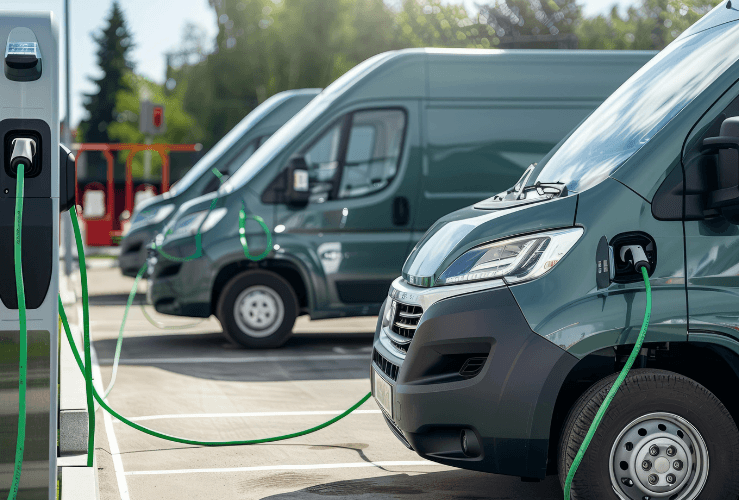From eco-minded driver training to investing in low-carbon vehicles, there are many ways to enhance your sustainable fleet management efforts - all while boosting productivity, cutting costs, and enhancing your credentials as a firm that really cares about the environment.
‘Going green’ has become a priority for fleets in recent years, driven by public concern over greenhouse gases and climate change. Government regulations, too, have been put in place to essentially compel both private individuals and companies to adopt more environmentally friendly technologies and approaches. In the UK, this has most notably come in the form of a ban on sales of new petrol and diesel vehicles by 2025.
But while there is a legal and moral imperative for sustainable fleet management, there are also rewards in the form of cost savings, improved efficiency, and enhanced reputation.
Here we explore the most effective ways to support your fleet’s carbon footprint reduction efforts.

1. Transition to Electric Vehicles or Hybrid Vehicles
Switching to electric vehicles is one of the most effective ways to reduce your fleet’s carbon emissions because EVs generate zero greenhouse gases in their day-to-day operations.
While the EV manufacturing process does create CO2 emissions, it’s generally agreed they are offset over the lifetime of the vehicle due to its green credentials.
EVs also require less maintenance compared to diesel and petrol engines, which should reduce costs.
With the UK ban on new petrol and diesel sales expected in just over a decade, it makes sense to adopt early.
Hybrid vehicles - ones that use one or more electric motors and a combustion engine - can also help you cut your carbon footprint and could be a sensible intermediate technology before going fully electric.
2. Implement Telematics and IoT Systems
Data-driven telematics and Internet of Things (IoT) devices help fleets operate in a safer, more efficient way. From route planning to identifying inefficient driving, they deliver real-time data on vehicles across a fleet, cutting costs, boosting productivity, and enhancing customer satisfaction levels.
By reducing fuel consumption and the need for maintenance and replacement parts, these technologies also help reduce the emissions associated with those tasks.
3. Promote Eco-Driving Practices
The way a vehicle is driven matters almost as much as its technological ability to use less fuel and its reputation for reliability.
When a driver accelerates and brakes too hard, or when they idle unnecessarily, they increase fuel consumption and component wear-and-tear.
Effective and ongoing driver training is the obvious solution here - encouraging drivers to use their vehicles in the most environmentally friendly way possible. The result of investing in this training should be lower fuel bills, reduced maintenance costs, longer vehicle lifespan - and a significant carbon footprint reduction.
4. Optimise Route Planning
By harnessing GPS and route planning software, as a fleet manager you can determine the quickest and most efficient route between two points. It helps you avoid congestion points, roadworks and other issues that could cause delays.
Naturally, advanced route planning systems reduce fuel consumption - while making your operation more effective and more profitable.

5. Regular Vehicle Maintenance
As any seasoned fleet manager knows, keeping your vehicles in good condition is crucial in order to avoid issues that could waste fuel.
From incorrectly inflated tyres to low oil levels and engine problems, a poorly maintained vehicle means higher fuel costs, increased repair costs (since small problems are allowed to turn into bigger ones) and of course, higher emissions.
6. Invest in Alternative Fuel Vehicles
Electric vehicles are not the only powertrains available to fleet managers. Other alternative fuel vehicles such as biodiesel, compressed natural gas (CNG) and hydrogen also have the potential to reduce both running costs and emissions.
Of course, there are issues with infrastructure with these less developed alternatives, but they are worth exploring with a view to future cost savings and environmental benefits.
7. Leverage Renewable Energy Sources
To really enter the premier league of environmentally friendly fleets, you need to consider taking bold measures like installing solar panels in depots and sourcing electricity from renewable energy providers. This will help ensure your EVs are operated in the most sustainable way possible and will also bolster your reputation among business partners, customers and the general public.

8. Engage in Carbon Offsetting
Another component of a truly comprehensive environmental strategy is to use carbon offsetting as a way to compensate for unavoidable emissions generated by your vehicles.
Such projects might include tree planting or renewable energy initiatives, both of which can limit or capture greenhouse gases.
Conclusion
As a fleet manager, you have a whole raft of tools at your disposal for cutting your organisation’s greenhouse emissions while meeting government regulations.
From switching to EVs to investing in telematics, from ongoing driver training to efficient route planning, there have never been more ways to make your operation greener, while boosting revenue, cutting costs and enhancing your standing as a fleet that truly cares about the environment.



